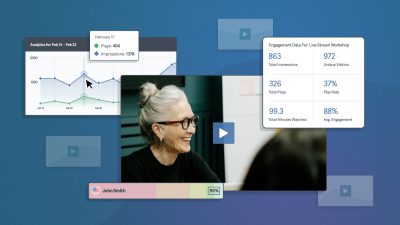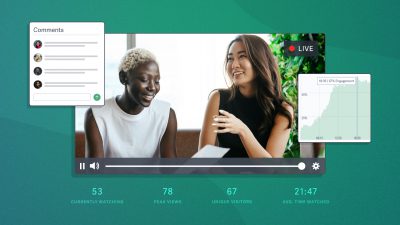Video can be used in a multitude of ways across many business functions because it’s proven to be one of the most effective mediums for communication. Here is the ultimate guide to implementing video throughout your organization to improve collaboration and efficiency, and the KPIs to track for your results as well.
Company Announcements
Especially in large, dispersed organizations, video is a critically important tool to keep everyone informed and up-to-date about recent and upcoming events in the company. Because video on demand can be accessed asynchronously, meaning anyone can access it at a time convenient for them, it’s the way to go for any internal company news.
You’ll likely want to make it really seamless for your employees to access your video, while also ensuring it can’t be shared outside of your company. Solutions like single-sign-on, IP address restriction, embedding them securely in an employee-only portal, or login protection are powerful ways to prevent unwanted sharing of your videos.
That being said, internal video is only effective at getting a message across if people actually watch it. Success, in this case, would mean high levels of engagement from all your intended recipients. You’ll want to be looking at how much of your video was watched, and by whom, to ensure all key parties are up to speed.
If possible, tag viewers with their email address to make who is watching, and who is not, crystal clear. Some video hosting providers, like SproutVideo, make it really easy to track viewers by email address in their engagement reporting.
Internal Collaboration
In this case, the idea is to facilitate communication with groups that need to share information when working on a project together. Video chats are one of the best replacements for meeting face-to-face, and are highly productive when compared to regular conference calls, since no one can secretly nod off when on camera.
What about the people who can’t make it to the call? Record them for future reference, and share them securely with the team. The same privacy settings as for company announcements would apply here, with the added measure of limiting video access to stakeholders.
In terms of KPIs, you’ll want to take the outcome of the project into consideration, as well as the efficiency of the team working on it. To evaluate the role video played, survey team members to get their take on how they used video to improve their process – a great way to figure out if it’s worth rolling out to other groups. Taking plays and engagement into account when evaluating the videos will help determine the types of discussions that were most fruitful and important to the project.
Educational Resources
To further the ongoing professional development of existing employees, having a video library of content they can reference at any point in their careers is an excellent way to encourage self-directed learning. Video is one of the fastest ways to help someone get up to speed because people have been shown to process video content much more quickly than text or audio alone.*
It’s really important to make sure that everyone is aware of these resources and how to access them, so include links in company-wide communications, such as quarterly newsletters, or post them on your company’s intranet. Keeping materials up-to-date is also key to ensure they remain relevant and useful, so conduct regular reviews of your educational company videos and rework any that need it.
In this case, you’ll want to track the popularity of plays and engagement levels to determine which videos are working well, or might need revising. Looking at this information by team or department could be helpful to see if any might need more training or resources to become more effective.
Interviewing
Video can save a lot of time when trying to identify qualified candidates for a job opening. Asking applicants to submit a short video introducing themselves and explaining why they are a great fit for a role will let you get a much better sense of their personality and style than if they just submit a written cover letter. Also, videos can be easily shared amongst hiring managers and other stakeholders, letting multiple people evaluate candidates simultaneously.
Providing clear instructions for applicants is critical so that they have the best chance of success when creating their videos. Making it easy to submit the application videos, and providing reassurance regarding the privacy of those videos, is also a best practice so candidates know their video won’t be publicly available on the internet in case they are currently employed.
If possible, comparing the quality and quantity of candidates that submitted a video with their application to those who did not, either for the same job or a comparable listing in the past, will give you a sense for the impact the video requirement had on your crop of candidates. Be sure to ask hiring managers if they found it to be a useful recruiting tool since they will likely have some insights to share.
On-boarding
When a prospective hire receives their job offer, they usually start imagining their new life at your firm right away. Why not stoke the fire of enthusiasm by including a video introducing the team they’ll be working with, and all the benefits your company has to offer?
A tour of the space where they’ll be working, and any notable on-site features, like a gym, daycare, or cool lounge areas would also help them picture themselves in the role. Any crucial information they need to know would also be good to include, as long as an upbeat, positive vibe is maintained to make sure they feel welcome and excited after viewing it. Bonus points if you manage to personalize it with their name, too.
Whether or not to allow them to share the video really depends on if you could consider it as a form of marketing for your company. Some people might be really enthused about the job offer and your company’s benefits, and want to share the video with their friends and family as a way of proclaiming that they got their dream job. In more delicate situations, where the candidate might still be employed elsewhere, or might be replacing someone recently let go, it would likely be unwise to permit public sharing of their welcome video.
In this case, tracking plays and engagement are a nice way of knowing your video was viewed by the candidate, and to also indicate whether it was shared or not. Obviously, the key metric here is really whether or not they ultimately accept the job.
Video on the Homepage or Marketing Site
Adding video to a public-facing website advertising your company’s products and services (referred to as a marketing site), is often intended to achieve one of two objectives: improve on-site SEO; or improve conversion rates.
In order to optimize your landing page video for SEO, start by identifying the search terms you’d like to target with your video, so you can incorporate them into the metadata associated with your video. This basically refers to any meta tags on the page that pertain to your video. Then, add the embedded video to your video sitemap, or create one to submit to search engines if you haven’t done so already.
To track improvements to video SEO, you’d want to look at your page rankings for the key terms you are targeting to track changes over time. Google Webmaster is a free and easy tool you can use for this, although there are certainly plenty of other good options out there. Be sure to mark the date you added or changed the video on your landing page so you can compare the ranking trends before and after. Other important stats to consider when evaluating the impact of your video would be time on site, bounce rate, and pages per visit, since all of those metrics should improve with the addition of video, and send signals to search engines about the relevancy of your page to specific keywords.
If you’re hoping to use this video to improve conversion rates, you’re off to a great start – multiple studies have shown that simply adding video to your website will help. If you finish your engaging content with a strong call-to-action, or point viewers to additional helpful resources that will nudge them along the sales cycle (like a whitepaper download or upcoming webinar), your odds of improving conversion rates would probably be even better.
The most relevant data here would be conversion rates over time for the specific conversions you are trying to drive with this video. For instance, a retailer would want to look at average order value and conversion rates for the customers who viewed the video, whereas a B2B business might look at the conversion rates for webinar signups or whitepaper downloads. Considering quality is important, too. Were the customers who watched the video more likely to become repeat purchasers? Did the webinar attendees who viewed your video wind up with higher service contracts than those who did not?
Lead Generation
Lead generation is a specific type of conversion where you capture contact information for a prospective customer, which allows you to nurture the lead, eventually driving sales and revenue. Whether your company relies on consultative sales, or is solely growing by inbound marketing, video can help improve efficiency of marketing spend and the quality of leads acquired.
The first method of capturing leads would be to use email gating for your content. This means any potential viewers would be required to enter their email address before being able to view your video. Surrounding your video with content that will provide context for why potential leads should be willing to fork over their personal information is key, so they feel confident in doing so. Use only the most intriguing, high-value videos for this tactic, such as interviews with experts, or exclusive information that can’t be found elsewhere.
Another method to use video to capture leads would be to use a post-play screen, which is the screen displayed once your video concludes. This can be a simple call-to-action with a link to a signup form, or a custom HTML form designed to send leads to a marketing platform or CRM platform of your choice.
Evaluating the efficacy of video for lead generation is best done by comparing the quality of the leads captured by your video(s) to those captured by other means, like whitepaper downloads or newsletter signups. In this case, lifetime value (LTV) is likely to be the best metric to use to determine the efficacy of your video for lead generation, though you can also look at the ROI of your video as well.
Brand Awareness
Also referred to as top-of-funnel marketing, brand awareness video campaigns are usually aiming for shares to reach the most people possible. Promoting content on social media, using calls-to-action to drive sharing, running a contest, or otherwise incentivizing specific viewer actions, are all tactics proven to work for brand awareness video campaigns.
The performance of a brand awareness campaign is determined largely by its reach, although quality is still a big factor. For instance, if your video was shared widely amongst your target niche with high rates of viewer engagement, that might be more valuable than if it was shared broadly across the internet, with many people skipping the majority of it, even though the number of plays might be higher.
How are you using video in your organization? Share with us in the comments below.
*As a data-hungry video nerd, I dug into the oft-quoted stat that people process visuals 60,000 times faster than text, but could not find a single scientific study to back it up. Someone else previously did a lot more work on this than I did, and you can look into his research about the 60,000 times faster stat here if you’re curious. Any links to the original source for that “fact” would be most welcome!
What I did find is a recent study from MIT that showed humans can recognize a visual image in as little as 13 milliseconds (ms). In comparison, data from speed reading studies shows that it can take anywhere from 100 to 500 ms to fixate the eye on text and transmit the information to our brain, and another 300 – 500 ms to comprehend its meaning.
If we take the average times of 225 ms for your eye to fixate on text, plus another 400 ms to comprehend it, you wind up at 625 ms to process textual information. This would potentially indicate that processing visual information is around 48 times faster (625/13) than text, rather than the popularly cited 60,000 times faster “fact” I haven’t been able to substantiate. Obviously, this number could vary quite a bit depending on the estimate used for the speed of processing text.
Just to add some complexity to the situation, some researchers consider the familiarity of the content to be a significant factor in the speed with which it can be processed, which seems logical. Dennis Proffit at UVA stated “Both picture and text processing vary with the familiarity with and complexity of the presented material, making direct comparison hard.” So, in other words, take these stats for what you will!








